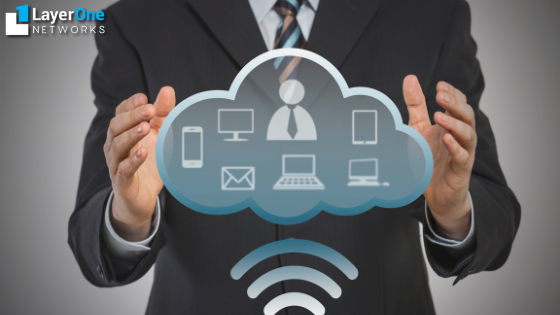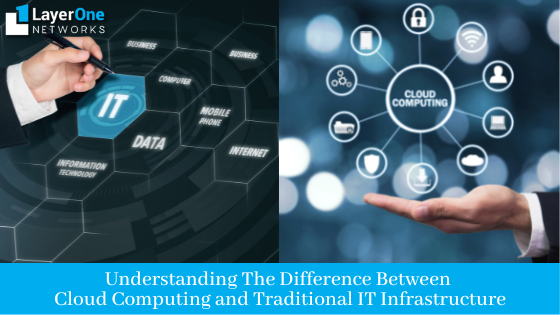Confused about choosing cloud or your traditional on-premise IT infrastructure?
Well, cloud computing and traditional IT infrastructure are different methods of running an enterprise. The former is a model where a third-party provider hosts your data and applications, while the latter is where you own and maintain your hardware and software.
In this blog, we will dig deep into some of the differences between these two types of infrastructure models in terms of setup, costs, flexibility, and scalability.
Infrastructure Setup

- Cloud Computing: Cloud computing refers to delivering hosted services over the internet. It allows users to access applications and storage over the internet without purchasing their hardware or software licenses. This makes it possible for companies to scale up or down as needed, which helps them save on costs associated with IT infrastructure maintenance.
It also helps with compliance because you don’t have to worry about keeping your data secure from hackers or malware attacks since everything resides in a secure offsite location managed by a third-party provider.
- Traditional IT Infrastructure: Traditional IT infrastructure refers to an on-premises setup where all applications and data are stored on company-owned hardware and software licenses. This setup can be expensive because businesses need to invest in new equipment every few years to keep up with demand for new features, not to mention all the additional costs associated with operating systems.
Scalability
- Cloud Computing: The ability of cloud computing to scale up or down as needed without any downtime or disruption is one of its key benefits. For example, if you need more storage space or processing power, you can simply add more resources by increasing the number of virtual machines (VMs) in your server farm. As you reduce your usage, you can shut down VMs and free up those resources for other uses.
- Traditional IT Infrastructure: In a traditional IT infrastructure, data is stored locally on your company’s servers or storage devices. In other words, all your data is stored in one place where it can be accessed locally by everyone who needs access. This means that if your business grows bigger and you need more storage capacity, you will need to buy more hardware and invest in expensive upgrades to keep up with demand.
Remote Flexibility

- Cloud Computing: Cloud computing allows you to access all your data from anywhere at any time without worrying about where it’s stored or how much space it takes up on your hard drive or server. This makes it easy for employees to work remotely since they don’t have to carry around laptops or tablets anymore; they just log into their PCs via VPN or some other secure connection method so they can access their files from their homes or while traveling on business trips.
- Traditional IT Infrastructure: Traditional IT infrastructures are rigid as they are difficult to change without significant cost implications or downtime associated. It is not flexible enough to meet the changing needs of businesses.
Costs
- Cloud Computing: Cloud computing solutions tend to be cheaper than traditional ones because they require less upfront investment on your part as well as reduced ongoing expenses such as maintenance fees or power bills. The pay-per-use model makes it easier to scale up or down your usage as needed without paying large setup fees or monthly minimums.
- Traditional IT Infrastructure: Traditional IT infrastructures are owned and operated by an organization directly. The organization owns all the hardware, software, operating systems, and applications needed to provide its employees with IT services. The organization also hires IT support staff members responsible for maintaining the infrastructure.
You may even need to hire an IT consultant service for managed services to handle your infrastructure. All of this contributes to a huge amount in the installation as well as the operating costs of the traditional IT infrastructure.
When Should You Choose One Over the Other?

Cloud computing has numerous benefits over traditional IT infrastructure
- It is flexible and scalable, meaning it can grow or shrink as needed based on your business needs.
- Cloud computing also offers increased security since your data is stored in a central location rather than on your computer.
- Cloud computing provides access to and uses IT resources as a service rather than building and maintaining them in-house. Cloud computing allows organizations to focus more on business innovation than IT maintenance and support.
- Additionally, it reduces costs by eliminating the need for equipment purchases and maintenance costs.
A traditional IT infrastructure has some advantages over cloud computing as well.
- A traditional IT infrastructure allows you greater control over your systems.
- Such control can be critical if you have sensitive data that must remain confidential or if there are compliance issues like HIPAA regulations requiring certain security measures that a public cloud service provider can’t fulfill.
If you want more information about the best choice for your organization, reach out to our IT consulting firm. Our IT support specialist is an expert in all things cloud computing and IT infrastructure and can guide you to make the right choice.

